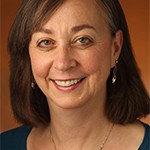by Tracy Barrett (W&M contributor)
It’s striking how much of medieval women’s literary output is description and explication of mystical visions. Why were so many medieval mystics female? Why did so many women claim to receive visions from God or the saints?
The reasons, paradoxically, are related to women’s lower status in society and the Church. First, women were considered to be more primitive than “intellectual” men and thus their connection with the Divine was more direct. This was reflected in their writing: since few women had the education to write in Latin, their writing in the vernacular “made possible a direct, unmediated relation with the Holy Ghost.”[i] Since a mystic was essential a passive conduit for the word of God, anyone, including an uneducated woman, might (if she were worthy) be chosen to take this role.[ii]
Also, since many positions of authority in the Church were denied to women, a woman feeling a connection to the Divine could not become a priest, much less rise in the Church hierarchy (legends like that of Pope Joan, a woman pope of the ninth century notwithstanding). But “[v]isionary women could bypass the human, male, authority of the Church on earth, and claim to be the instruments of a higher, divine authority.” Not only did this give them a powerful voice, but also “[i]n this way, . . . they could validate their activity as writers.”[iii] At a time when “Christianity . . . came to forbid women the genre of the sermon; it tolerated–even feared and revered–their visions.”[iv]

Hildegard von Bingen, probably the most famous medieval mystic, dictating a vision represented by flames coming from (or going to) her head
The Church hierarchy did manage to get involved, of course. No one could expect to have her claim of mystical experience accepted without question. Doubtless in an out-of-the-way village a woman could be revered as a visionary with no stamp of authority, and some women—and men—undoubtedly were called mystics without validation from the authorities. But these people ran the risk of being accused of heresy for taking the word of the Devil as the word of God. The Church developed mechanisms to recognize what it considered “true” visions, often including a kind of trial, or an interview with an established mystic, or some other test.
Most mystics followed a relatively orderly progression in their visionary life.[v] First came purgation and self-loathing, often characterized by anorexia (which sometimes lasted the duration of the mystic’s life). The next step often involved more outward-looking evidence of a special gift: telling someone what scandal she is hiding, for example, or what is his secret wish. Some mystics would then claim they had authority to interpret the Bible—a dangerous step, for a thin line divides interpretation and preaching, a practice strictly forbidden to women. Next would usually come devotional visions that arose from meditation on a saint, usually the Virgin Mary, or Christ.
Almost invariably the mystic would then have an experience of Christ’s crucifixion, and—what often strikes modern readers as odd and unsettling—frequently a visionary experience of sexual union with Christ. Medieval thinkers did not have as much of a problem accepting this kind of vision as do moderns: The mystic was in effect wedding Christ through her visions, and a marriage, after all, must be consummated. Also, erotic and spiritual ecstasy were—and often still are—closely linked, for both men and women. Margery Kempe, although desperate to be declared a legitimate mystic, was honest enough to admit that although Christ appeared to her naked, she wasn’t able to do more than grasp his toes!
The last stage was a vision of universal order. When this step was achieved, the vision attained was frequently very difficult for the mystic to explain and others to understand. Today this difficulty tends to either attract readers eager to puzzle out the mystery, or repel those baffled by the vision’s opacity.
[i] Danielle Régnier-Bohler, “Literary and Mystical Voices,” in Christiane Klapisch-Zuber, ed. A History of Women in the West. Vol. II: Silences of the Middle Ages. Cambridge and London: Belknap Press of Harvard University Press, 1992, p. 447.
[ii] See, for example, the ancient Greek Pythia who spoke with the voice of Apollo at the Oracle at Delphi. She was invariably an uneducated peasant woman.
[iii] Alexandra Barratt, ed. Women’s Writing in Middle English. London and New York: Longman, 1992, p. 8.
[iv] Julia Bolton Holloway, Constance S. Wright, and Joan Bechtold, eds. Equally in God’s Image: Women in the Middle Ages. New York: Peter Lang, 1990, p. 3.
[v] Adapted from Elizabeth Alvilda Petroff. Medieval Women’s Visionary Literature. New York and Oxford: Oxford University Press, 1986.
 Tracy Barrett is the author of numerous books for young readers, most recently Dark of the Moon (Harcourt) and the Sherlock Files series (Henry Holt). Forthcoming from Harlequin Teen in July, 2014 is The Stepsister’s Tale. She lives in Nashville, TN, where until recently she taught Italian, Humanities, and Women’s Studies at Vanderbilt University, before transitioning to being a full-time writer. Visit her website and her blog.
Tracy Barrett is the author of numerous books for young readers, most recently Dark of the Moon (Harcourt) and the Sherlock Files series (Henry Holt). Forthcoming from Harlequin Teen in July, 2014 is The Stepsister’s Tale. She lives in Nashville, TN, where until recently she taught Italian, Humanities, and Women’s Studies at Vanderbilt University, before transitioning to being a full-time writer. Visit her website and her blog.
